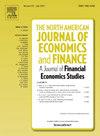Enhancing financial stability through prospective resilience: Insights from the EN-VAR-DY-PR framework in international stock market networks
IF 3.9
3区 经济学
Q1 BUSINESS, FINANCE
North American Journal of Economics and Finance
Pub Date : 2025-09-19
DOI:10.1016/j.najef.2025.102539
引用次数: 0
Abstract
The increasing interconnectedness and systemic vulnerabilities of financial networks underscore the necessity of enhancing their resilience to shocks and ensuring the stability of the global financial system. This paper proposes the EN-VAR-DY-PR framework, which integrates Elastic Net (EN) regularization, Vector Autoregression (VAR), and the Diebold–Yilmaz (DY) index. This novel approach enables the dynamic assessment of prospective resilience (PR) in complex financial networks, capturing both temporal and structural dimensions of risk. Focusing on three scenarios – economic blockade, financial liberalization, and random behavior – this research examines the dynamic evolution of network prospective resilience across three distinct periods marked by major market crises. Empirical analysis of 40 countries reveals that while economic blockade temporarily enhances network resilience, it undermines long-term shock absorption. Conversely, financial liberalization consistently improves network stability, and an optimal level of randomness significantly improve the resilience of financial networks and strengthen overall financial stability. Additionally, over the three periods, the clustering of the network decreases and the network becomes more homogeneous, suggesting heightened risk concentration and intensified interconnectedness. The significant growth in both the prospective resilience and volatility of network modularity underscores an escalating systemic vulnerability and a weakening of overall network stability. This study provides a novel perspective on financial stability, demonstrating how network science can effectively identify systemic vulnerabilities and inform strategies to mitigate systemic risks.
通过预期弹性增强金融稳定:来自国际股票市场网络EN-VAR-DY-PR框架的见解
金融网络的互联性和系统性脆弱性日益增强,凸显了增强金融网络抵御冲击能力和确保全球金融体系稳定的必要性。本文提出了EN-VAR-DY- pr框架,该框架集成了弹性网络(EN)正则化、向量自回归(VAR)和Diebold-Yilmaz (DY)指数。这种新颖的方法能够动态评估复杂金融网络中的预期弹性(PR),同时捕获风险的时间和结构维度。本研究着眼于经济封锁、金融自由化和随机行为三种情景,考察了网络预期弹性在三个以重大市场危机为标志的不同时期的动态演变。对40个国家的实证分析表明,虽然经济封锁暂时增强了网络弹性,但它破坏了长期的冲击吸收。相反,金融自由化持续提高网络稳定性,最优随机性水平显著提高金融网络的弹性,增强整体金融稳定性。此外,在这三个时期,网络的聚类性降低,网络变得更加均匀,表明风险集中度提高,互联性增强。网络模块化的预期弹性和波动性的显著增长强调了系统脆弱性的升级和整体网络稳定性的减弱。这项研究为金融稳定提供了一个新的视角,展示了网络科学如何有效地识别系统脆弱性,并为减轻系统风险的策略提供信息。
本文章由计算机程序翻译,如有差异,请以英文原文为准。
求助全文
约1分钟内获得全文
求助全文
来源期刊
CiteScore
7.30
自引率
8.30%
发文量
168
期刊介绍:
The focus of the North-American Journal of Economics and Finance is on the economics of integration of goods, services, financial markets, at both regional and global levels with the role of economic policy in that process playing an important role. Both theoretical and empirical papers are welcome. Empirical and policy-related papers that rely on data and the experiences of countries outside North America are also welcome. Papers should offer concrete lessons about the ongoing process of globalization, or policy implications about how governments, domestic or international institutions, can improve the coordination of their activities. Empirical analysis should be capable of replication. Authors of accepted papers will be encouraged to supply data and computer programs.

 求助内容:
求助内容: 应助结果提醒方式:
应助结果提醒方式:


